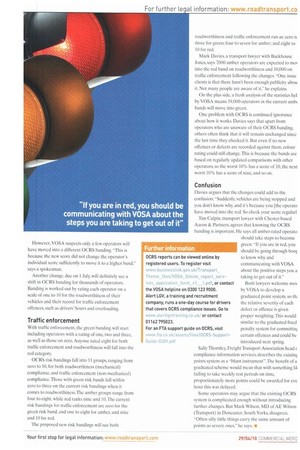Traffic enforcement
Page 29

If you've noticed an error in this article please click here to report it so we can fix it.
With traffic enforcement, the green banding will start including operators with a rating of one. two and three.
as well as those on zero. Anyone rated eight for both Gutde-0209.pdt traffic enforcement and roadworthiness will fall into the red category.
OCRS risk bandings fall into 11 groups, ranging from zero to 10, for both roadworthiness (mechanical) compliance, and traffic enforcement (non-mechanical) compliance. Those with green risk bands fall within zero to three on the current risk bandings when it comes to roadworthiness. The amber groups range from four to eight. while red ranks nine and 10. The current risk bandings for traffic enforcement are zero for the green risk band, and one to eight for amber, and nine and 10 for red.
The proposed new risk handings will see both roadworthiness and traffic enforcement run as: zero tc three for green: four to seven for amber: and eight to 10 for red.
Mark Davies, a transport lawyer with Back house Jones, says 7,000 amber operators are expected to mol into the red band on roadworthiness and 10,000 on traffic enforcement following the changes. "One issue clients is that there hasn't been enough publicity abou it. Not many people are aware of it," he explains.
On the plus side, a fresh analysis of the statistics hel by VOSA means 19,000 operators in the current ambt bands will move into green.
One problem with OCRS is continued ignorance about how it works. Davies says that apart from operators who are unaware of their OCRS banding, others often think that it will remain unchanged since the last time they checked it. But even if no new offences or defects are recorded against them, colour rating could still change. This is because the bands are based on regularly updated comparisons with other operators, so the worst 10% has a score of 10. the next worst 10% has a score of nine, and so on.
Confusion
Davies argues that the changes could add to the confusion. "Suddenly, vehicles are being stopped and you don't know why. and it's because you [the operato have moved into the red. So check your score regularl Tim Cu1pin, transport lawyer with Chester-based Aaron & Partners, agrees that knowing the OCRS banding is important. He says all amber-rated operato should take steps to become green. "If you are in red, you should be going through hoof to know why and communicating with VOSA about the positive steps you a taking to get out of it."
Both lawyers welcome mox by VOSA to develop a graduated point system. so th; the relative severity of each defect or offence is given proper weighting. This would similar to the graduated fixed penalty system for committim certain offences and could be introduced next spring.
Sally Thorn icy. Freight Transport Association head c compliance information services, describes the existinl points system as a "blunt instrument". The benefit of a graduated scheme would mean that with something lit failing to take weekly rest periods on time, proportionately more points could be awarded for eve hour this was delayed.
Some operators may argue that the existing OCRS system is complicated enough without introducing further changes. But Mark Wilson. MD of AE Wilson (Transport) in Doncaster. South Yorks, disagrees. -Often silly little things carry the same amount of points as severe ones," he says. •




























































































































